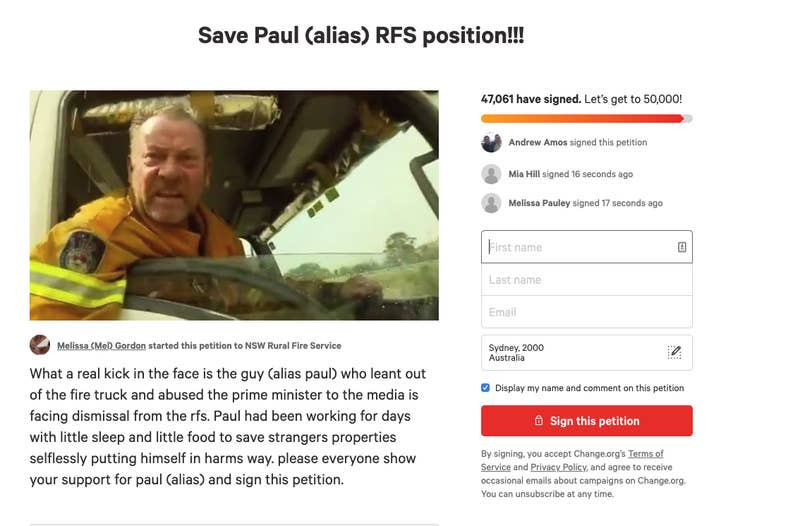The truth behind this viral image of the Australian bushfires
Words by Nick Whigham
The scale of the bushfire disaster and the horrifying images emanating from Australia right now need no exaggeration – and yet, deliberately or not, images and claims have been circulating online that aren’t what they appear to be.
There have been numerous pictures, videos and claims spread online during this ongoing crisis that don’t stack up. Some appear to have been deliberately intended to spread falsehoods while others accidentally took on a life of their own on social media, with the underlying truth becoming lost along the way.
One of the latest is a widely shared composition image of satellite data purporting to show fire-affected areas for the past four weeks, with the 3D render of the image giving an exaggerated effect (and also includes routine dry season burn offs in the north). However many have shared it believing it shows the scale of fires from space.
After it went viral, creator Anthony Hearsey, sought to clarify the true nature of the image.
“Didn’t realise this would go viral ... This is a 3D visualisation of the fires in Australia. NOT A PHOTO. Think of this as a prettier looking graph,” he explained.
“This is made from data from NASA’s FIRMS (Satellite data regarding fires) between 05/12/19 - 05/01/20. These are all the areas which have been affected by bushfires.
“Scale is a little exaggerated due to the render’s glow, but generally true to the info from the NASA website. Also note that NOT all the areas are still burning, and this is a compilation.”
Despite the clarification, it continued to be shared Tuesday morning including by celebrity Jason Momoa who posted it to his 14.4 million Instagram followers.
Another pair of images doing the rounds shows continental Australia being overlaid with the United States with an exaggerated number of fires burning. One has even been posted by America’s ABC News.
Another one of these. This is ridiculous, @ABC. The fires are huge but this is a reckless misrepresentation. Take it down. https://t.co/MLaOez9U2G
— Paul Colgan (@Colgo) January 7, 2020
It follows a string of misinformation and misrepresentation online surrounding the bushfires.
An online petition this week which claimed a volunteer fire fighter who delivered an expletive-laden reproach to the Prime Minister could be stood down was completely untrue.
Earlier, a particularly harrowing photo of a mother and her children hiding in the water to escape 2013 fires in Tasmania was circulated as if it was from the current disaster.
(1/3) This has 30k+ likes & retweets yet the second photo is from 2013 during the Dunalley fires in Tasmania. Not Australia currently. It’s inaccurate. Please be mindful when you see tweets like this. https://t.co/R6lXuuP5gL
— Faley Goyette (@faley_goyette) January 6, 2020
At the more extreme end, some accounts, including online bots, have shared the more ludicrous conspiracy theory that environmentalists are lighting fires to further the agenda of climate action. While The Australian reported on Tuesday there has been 183 arrests made this fire season for arson, there has been no suggestion or evidence that any of them have been politically or ideologically motivated.
According to Dr Timothy Graham from Queensland’s University of Technology, there is a lot of bot and troll activity surrounding the #ArsonEmergency hashtag, with a disproportionate amount of tweets coming from a small group of accounts that show telltale signs of automation.
“Based on my analysis it appears that the bushfires have catapulted Australia into the global disinformation space, and the #ArsonEmergency hashtag is a prime example right now,” he told Yahoo News Australia.
The corrosive affect of false information
While misinformation is not a new problem, it can be a problem that goes global very quickly with the opaque and ubiquitous world of social media.
Aside from muddying the waters during the time of a crisis, the big problem is that it erodes the overall trust in information being disseminated under the catch-all term of media.
Dr Andrea Carson is an Associate Professor in the Department of Politics, Media and Philosophy at Melbourne’s La Trobe University and has researched the “weaponisation” of fake news and the changing nature of online misinformation.
She says there is a “direct correlation” between declining trust in media and the explosion of social media as a news source.
“A lot of the platforms have information that is not of high quality,” she told Yahoo News Australia. “It
With many Australians relying on the ABC to get the vital information during this bushfire crisis – sometimes exclusively via radio when the power has been down – the importance of good reporting is rarely more clear. But despite the immensely important role it plays, trust is media institutions, including the ABC, has declined in recent years.
When it comes to polling, “the ABC is still on top, but it’s come down quite a bit and part of that is the politicisation of the ABC and accusations it has a left-wing agenda,” she said.

Some users who rely on aggregators like Facebook might not differentiate between credible sources like the ABC and far less reputable websites, Dr Carson said. And ultimately, Facebook can be used to target certain demographics online where “disinformation feeds into their confirmation bias”.
There is a distinction to be made between the more accidental and subtle forms of misinformation and “disinformation that is deliberately and maliciously spread propaganda for different motivations,” she points out.
But in terms of tackling the problem, debate continues about the media’s responsibility to proactively combat accusations of “fake news” and the responsibility for tech companies to do more to mitigate the spread of false information online.
“These are not easy problems to solve,” Dr Carson said.

 Yahoo News
Yahoo News 
